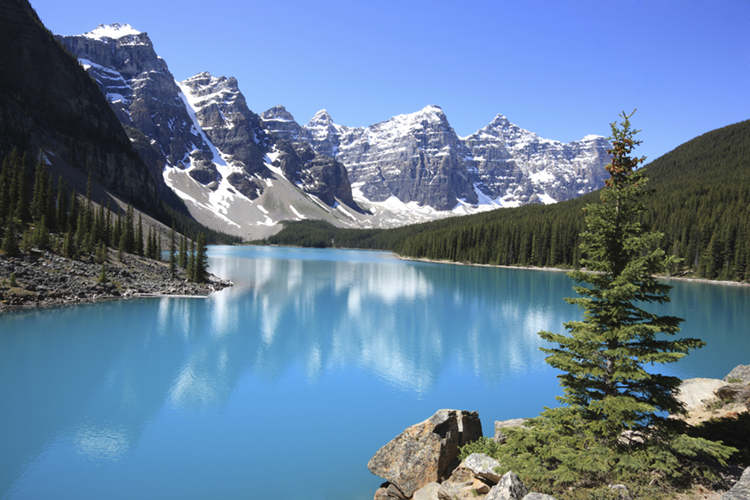A train rolls along Banff National Park’s Bow River in 2005. The national park was created 130 years ago today on June 23, 1887. Credit: © Shutterstock
One hundred and thirty years ago today, on June 23, 1887, the Canadian government established Rocky Mountains Park as Canada’s first official national park. Known now as Banff National Park, the park’s spectacular scenery has long made it one of Canada’s most popular tourist attractions. The park has many deep valleys, glaciers, lakes, and snow-capped mountains. It lies on the eastern side of the Rocky Mountains in southwestern Alberta. Originally established as Banff Hot Springs Reservation in 1885, Banff is Canada’s oldest national park.
Many features of Banff National Park have been shaped by glaciers during the past million years. Many glaciers still exist in the mountains, but steadily warming temperatures have reduced the number of glaciers in recent decades. Scientists blame the warming temperatures and glacier melt on global warming. Accelerated glacier melt is a problem throughout the Rocky Mountains. It can be seen along Banff National Park’s stretch of the famous Icefields Parkway, where gaps and lakes have formed among the formidable walls and sheets of ice. The Icefields Parkway, a 144-mile (232-kilometer) scenic highway, runs through Banff and Jasper National Park at the heart of the Canadian Rocky Mountain Parks World Heritage Site. World Heritage Sites are places of unique cultural or natural importance as designated by the United Nations Educational, Scientific and Cultural Organization (UNESCO).
Streams formed by the meltwaters of Banff’s glaciers feed such lakes as Bow Lake, Lake Louise, Moraine Lake, and Peyto Lake. Banff’s deep valleys have dense forests chiefly populated by lodgepole pine trees. Subalpine fir, Engelmann spruce, and Lyall’s larch grow at higher elevations. The Castleguard Caves, in the park’s northwest, make up the longest cave system in Canada. Animals in the park include bighorn sheep, black and grizzly bears, deer, elk, moose, mountain goats, and a small herd of bison.

Beautiful Moraine Lake is fed by glacier meltwaters in Canada’s Banff National Park. Credit: © Thinkstock
Visitors to Banff National Park can enjoy many outdoor activities. Over 1,000 miles (1,600 kilometers) of trails provide hiking routes. In winter, cross-country skiers use many of the trails. The park also has three downhill skiing areas. Summer visitors may enjoy canoeing and other water sports on the lakes and streams. Near the town of Banff in the southern part of the park is a public pool fed by hot mineral springs. The park’s many campgrounds have more than 2,000 campsites. Visitors may also take bus tours of the park and visit national historic sites within the park.
In 1883, railway workers discovered hot mineral springs in an area near what is now the town of Banff. Several people tried to buy the land and use the springs for private gain. But in 1885, the Canadian government declared 6,400 acres (2,600 hectares) around the springs to be a public land reserve. In 1887, the government expanded the reserve to 156 square miles (405 square kilometers) and officially declared it a national park. The park’s name was changed to Banff National Park in 1930. Today, the park covers 1,641,000 acres (664,100 hectares).
Untitled Document
Can't view the linked articles? Subscribe to World Book Online

World Book Online delivers a progressive sequence of core databases supported by supplemental
tools, such as language translation, graphic organizers, and unique Webquests. Moving from
Early World of Learning to World Book Advanced, World Book Online aligns end-users with their
appropriate learning levels. Each stand-alone site provides additional features to support the
needs of users’ specific capabilities.
The World Book Difference
World Book combines cutting-edge technology with traditional editorial excellence to produce
authoritative, trustworthy, and unbiased content. The digital content is updated in real time and
carefully curated for each learning level. Accessible 24/7, the content is available on a variety of devices.
World Book Online combines 21st-century instructional techniques with timely information.
By breaking down complex topics and using easily understandable text, World Book Online helps to
build fluency and increase comprehension. Featuring single sign-on capability, these sites are paired
with highly visual content to engage even the most reluctant reader. Our collection of resources kindles
a lifelong learning experience for every user. This adherence to clarity, currency, and accuracy makes
World Book’s digital offerings an information hub for the classroom, library, and beyond.